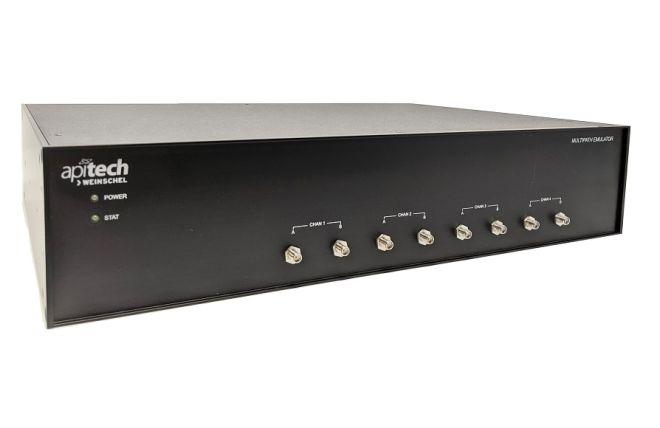Engineers developing new IoT and cellular devices are staring down the barrel of a much more challenging test environment. Fortunately, there are also engineers developing new and better technology for wireless RF testing. Many of the advances in RF testing are improvements in the capabilities, extensibility, and configurability of RF testing equipment, as well as the development of hardware and software approaches to aid in device and network testing. Other advances have led to the development of behemoth multiport test environments comprised of configurable hardware, such as FPGAs, multitudes of digital-to-analog (D/A)/analog-to-digital (A/D) conversion, frequency conversion, and RF Front Ends (RFFEs).
A question emerges then, do you lose fidelity by digitally processing and regenerating test signals? The answer is that channel emulators/simulators can enable very complex network testing scenarios with the potential of artificial signal processing and noise/distortion injection, but at the cost of sacrificing real RF conditions throughout the test channel. The emulated signals will contain additional artifacts, from the repeated domain and frequency conversion steps. These conversion stages also add latency that wouldn’t normally exist in a radio channel. Moreover, these systems present limited hardware flexibility, channel model availability, and scalability compared to real RF test environments, and at a much higher cost point.
With this article, my goal is to convey an understanding of the differences between RF conducted test and radio channel emulators/simulators, focusing specifically on throughput testing. I think this understanding is a key to us making optimal decisions for IoT and cellular device/system development.
Solving your test challenges with a Conducted RF Test Environment
In a real wireless RF system every device, component, and interconnect can represent a significant node or impairment in the network. Each of these impairments impacts the characteristic of signals passing through them, adding noise, phase noise/jitter, distortion, attenuation, or reflections.
A real conducted wireless RF test environment consists of using actual RF devices and components to control and manipulate the signals in the test environment. Common components used in creating an RF test environment include attenuators, phase shifters, filters, power dividers/combiners, couplers, antennas, coaxial transmission lines, and channel matrices. An important property of passive RF networks is the reciprocity of the network. This means that regardless of the direction of propagation of the signals in the system, the transmission parameters are the same. Outside of the radio hardware, a typical RF channel is reciprocal.
RF Testing With Radio Channel Emulators/Simulators
A channel emulator RF test environment uses digitized measurements or recordings of signals that are then manipulated using digital software/hardware methods. Test systems that are capable of these functions are generally called radio channel, channel, or wireless network emulators or simulators. These altered signals are then converted from digital to RF signals that are then sent to a DUT. Generally, analog-to-digital converters (ADCs) and digital-to-analog converters (DACs) are used to convert between digital and analog/RF regimes. It is important to note that ADCs and DACs have limitations that prevent perfect capture or generation of RF signals and distortion, and other signal degrading characteristics are unavoidably part of this conversion. Moreover, current DACs and ADCs are limited in bandwidth and introduce cost constraints. Therefore, additional frequency translation hardware may be used, which results in added signal distortion and signal characteristics to the channel that wouldn’t normally be there.
Some channel emulators/simulators can inject noise, distortion, interference, and other signal degrading factors to simulate the effects of a real RF environment. Some more sophisticated synthetic RF test environments can fully emulate 4G/LTE evolved Node B (eNB), 5G general Node B (gNB), and Wi-Fi access points (APs) with a completely synthetic channel between DUTs. These features are incredibly useful, as a myriad of scenarios can be rapidly played through without having to do additional setup. However, these benefits come at a significant cost per channel.
The added impairments signal characteristics are injected into the signal using digital signal processing (DSP) technology in either software or hardware. DSP microcontrollers (MCUs) can be used to manipulate a signal using software, or a digital hardware system can be developed using an FPGA.
It is expensive and difficult to perform real-time processing on the latest high throughput and multi-channel communication standards given the high frequency of operation, bandwidth, signal complexity, and data rates. Hence, these RF signals typically downconverted, digitized, demodulated, are processed/manipulated, modulated, synthesized, and upconverted between the APs and UEs.
Conducted RF Vs. Channel Emulators
Both RF test environments and channel emulators have their place in the development and production test of cellular base stations and UE. Though it might be attractive to rely solely on sophisticated channel emulators as the diversity of test and extent of the signal/channel manipulation capability can seem impressive, these synthetic systems aren’t always well suited for fully preparing a communications system for real-world deployment.
The main reason for this is that outside of the extremely high costs of sophisticated channel emulators, these systems also can introduce unintended impairments. Channel emulators tend to introduce latency that is far beyond what a real channel would experience. Some added latency is impossible to avoid with DSP based channel emulators, as additional conversion and signal processing stages will inevitably add some delay. This is a problem, especially with TCP-IP traffic and other protocols with handshakes, as the added latency will artificially lower the throughput of the system and prevent testing of true system performance achievable with a real RF channel.
Another consideration that the RFFE of a DUT and AP have unique characteristics that can’t be 100% accurately captured or emulated. When a channel emulator demodulates and reprocesses a signal it changes the signal characteristics unavoidably.
A large capital expense on a channel emulator limits the upgradability and configurability of an RF test environment, as the hardware integrated into the channel emulator is fixed. Adding additional channels or features may be inconvenient/costly, or even impossible. Moreover, if new wireless standards emerge that are beyond the capabilities of the synthetic RF test system to emulate, a new system would have to be purchased or otherwise factory retrofitted.
If you are curious about how to take the first steps in the journey to create real RF test systems for the latest IoT and cellular devices and systems, send me an email at commercialwireless@am.spectrumcontrol.com with your questions or thoughts and I will try and answer.
Stay tuned for future articles covering additional discussions of Butler matrices in radio and wireless network testing, multipath emulation, and tackling test challenges for military/defense radio systems.





